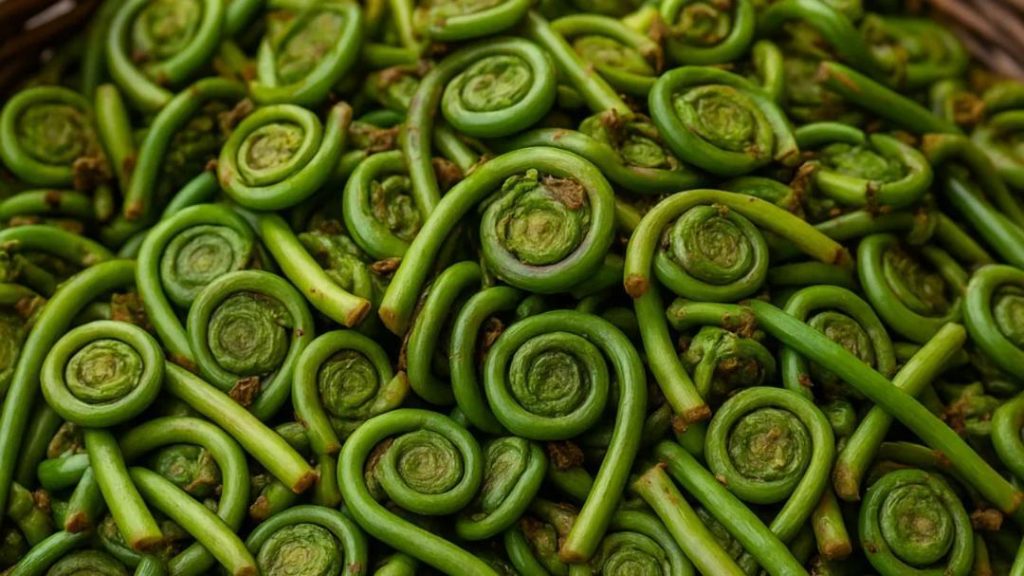
Lingad, a Monsoon Fern, Boosts Immunity and Bone Health
The monsoon season in the Himalayas brings with it a treasure trove of edible delights, one of which is the Lingad, also known as fiddlehead fern. This young, coiled shoot is a delicacy in many parts of India, particularly in the northeastern states and the Himalayan regions. For centuries, the locals have been foraging for Lingad during the monsoon season, when it is at its tender and curled best. In this blog post, we will explore the unique flavor, rich tradition, and impressive health benefits of Lingad, making it a must-try ingredient for any adventurous foodie or health enthusiast.
What is Lingad?
Lingad (Diplazium esculentum) is a type of fern that grows in the wild, particularly in the Himalayas and other mountainous regions of India. It is also known as Lengdu, Dhekia, or Nigro, depending on the region. The fern is harvested when it is young and still curled, before it matures and becomes fibrous and unfit for cooking. The Lingad is a staple ingredient in many traditional recipes, particularly in the northeastern states of India, such as Meghalaya, Assam, and Manipur.
Unique Flavor and Tradition
The Lingad has a unique, slightly sweet and earthy flavor that is unlike any other ingredient. The locals have been cooking with Lingad for generations, and it is an integral part of their traditional cuisine. The fern is often cooked with spices, herbs, and other ingredients to create a flavorful and aromatic dish. In Meghalaya, for example, Lingad is often cooked with chilies, garlic, and mustard oil to create a spicy and savory side dish.
In Assam, Lingad is a key ingredient in the traditional dish, “Dhekia jhol,” a spicy curry made with Lingad, chilies, garlic, and mustard oil. In Manipur, Lingad is cooked with fermented fish and other ingredients to create a flavorful and nutritious stew.
Health Benefits
The Lingad is not only a delicacy, but it also has a plethora of health benefits. The fern is densely nutrient-rich, containing a range of vitamins, minerals, and antioxidants. It is an excellent source of vitamin A, vitamin C, and potassium, making it an excellent ingredient for boosting immunity and supporting overall health.
Boosts Immunity
The Lingad contains a range of antioxidants and anti-inflammatory compounds that help to boost immunity and protect the body against diseases. The fern has been traditionally used to treat a range of health conditions, including respiratory problems, fever, and digestive issues.
Supports Bone Health
The Lingad is also an excellent source of calcium, magnesium, and other essential minerals that are crucial for bone health. The fern has been traditionally used to treat bone-related conditions, such as osteoporosis and arthritis.
How to Cook Lingad
Cooking Lingad is relatively simple, although it does require some care to ensure that the fern retains its unique flavor and texture. Here are a few tips on how to cook Lingad:
- Rinse the Lingad thoroughly with water to remove any dirt or debris.
- Blanch the Lingad in boiling water for 5-7 minutes to remove any bitterness.
- Chop the Lingad into small pieces and sauté it with garlic, ginger, and other spices.
- Add the Lingad to a variety of dishes, such as stir-fries, curries, or soups.
Conclusion
In conclusion, the Lingad is a unique and flavorful ingredient that is steeped in tradition and rich in health benefits. Whether you are a foodie looking to try something new or a health enthusiast seeking a natural way to boost immunity and support bone health, the Lingad is definitely worth trying. With its unique flavor and dense nutrient profile, the Lingad is an ingredient that is sure to delight and benefit anyone who tries it.
Source:






